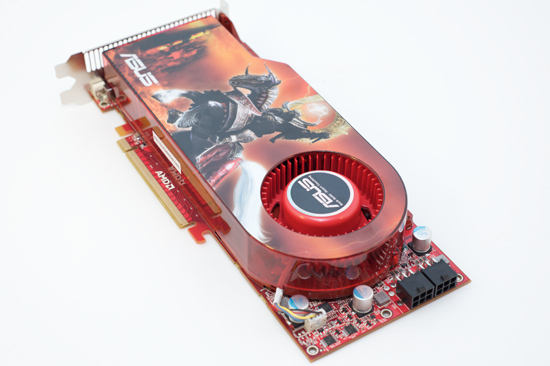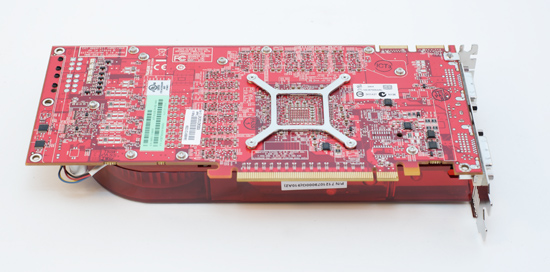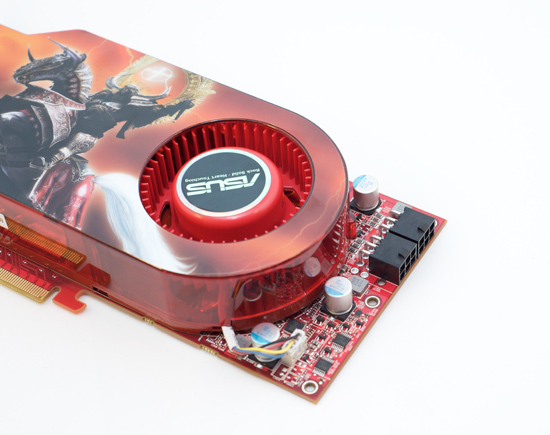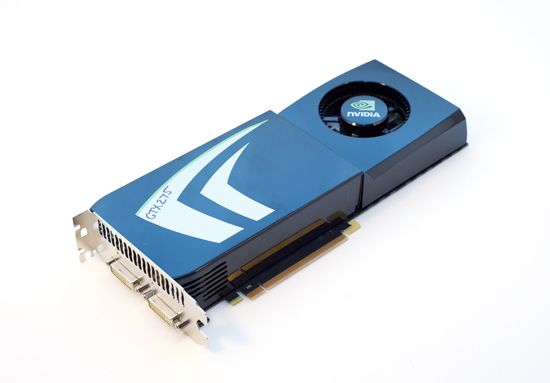ATI Radeon HD 4890 vs. NVIDIA GeForce GTX 275
by Anand Lal Shimpi & Derek Wilson on April 2, 2009 12:00 AM EST- Posted in
- GPUs
The Cards and The Test
In the AMD department, we received two cards. One was an overclocked part from HIS and the other was a stock clocked part from ASUS. Guess which one AMD sent us for the review. No, it's no problem, we're used to it. This is what happens when we get cards from NVIDIA all the time. They argue and argue for the inclusion of overclocked numbers in GPU reviews when it's their GPU we're looking at. Of course when the tables are turned so are the opinions. We sincerely appreciate ASUS sending us this card and we used it for our tests in this article. The original intent of trying to get a hold of two cards was to run CrossFire numbers, but we only have one GTX 275 and we would prefer to wait until we can compare the two to get into that angle.



The ASUS card also includes a utility called Voltage Tweaker that allows gamers to increase some voltages on their hardware to help improve overclocking. We didn't have the chance to play with the feature ourselves, but more control is always a nice feature to have.

For the Radeon HD 4890 our hardware specs are pretty simple. Take a 4870 1GB and overclock it. Crank the core up 100 MHz to 850 MHz and the memory clock up 75 MHz to 975 MHz. That's the Radeon HD 4890 in a nutshell. However, to reach these clock levels, AMD revised the core by adding decoupling capacitors, new timing algorithms, and altered the ASIC power distribution for enhanced operation. These slight changes increased the transistor count from 956M to 959M. Otherwise, the core features/specifications (texture units, ROPs, z/stencil) remain the same as the HD4850/HD4870 series.
Most vendors will also be selling overclocked variants that run the core at 900 MHz. AMD would like to treat these overclocked parts like they are a separate entity altogether. But we will continue to treat these parts as enhancements of the stock version whether they come from NVIDIA or AMD. In our eyes, the difference between, say, an XFX GTX 275 and an XFX GTX 275 XXX is XFX's call; the latter is their part enhancing the stock version. We aren't going to look at the XFX 4890 and the XFX 4890 XXX any differently. In doing reviews of vendor's cards, we'll consider overclocked performance closely, but for a GPU launch, we will be focusing on the baseline version of the card.
On the NVIDIA side, we received a reference version of the GTX 275. It looks similar to the design of the other GT200 based hardware.

Under the hood here is the same setup as half of a GTX 295 but with higher clock speeds. That means that the GTX 275 has the memory amount and bandwidth of the GTX 260 (448-bit wide bus), but the shader count of the GTX 280 (240 SPs). On top of that, the GTX 275 posts clock speeds closer to the GTX 285 than the GTX 280. Core clock is up 31 MHz from a GTX 280 to 633 MHz, shader clock is up 108 MHz to 1404 MHz, and memory clock is also up 108 MHz to 2322. Which means that in shader limited cases we should see performance closer to the GTX 285 and in bandwicth limited cases we'll still be faster than the GTX 216 because of the clock speed boost across the board.
Rather than just an overclock of a pre-existing card, this is a blending of two configurations combined with an overclock from the two configurations from which it was born. And sure, it's also half a GTX 295, and that is convenient for NVIDIA. It's not just that it's different, it's that this setup should have a lot to offer especially in games that aren't bandwidth limited.
That wraps it up for the cards we're focusing on today. Here's our test system, which is the same as for our GTS 250 article except for the addition of a couple drivers.
The Test
| Test Setup | |
| CPU | Intel Core i7-965 3.2GHz |
| Motherboard | ASUS Rampage II Extreme X58 |
| Video Cards | ATI Radeon HD 4890 ATI Radeon HD 4870 1GB ATI Radeon HD 4870 512MB ATI Radeon HD 4850 NVIDIA GeForce GTX 285 NVIDIA GeForce GTX 280 NVIDIA GeForce GTX 275 NVIDIA GeForce GTX 260 core 216 |
| Video Drivers | Catalyst 8.12 hotfix, 9.4 Beta for HD 4890 ForceWare 185.65 |
| Hard Drive | Intel X25-M 80GB SSD |
| RAM | 6 x 1GB DDR3-1066 7-7-7-20 |
| Operating System | Windows Vista Ultimate 64-bit SP1 |
| PSU | PC Power & Cooling Turbo Cool 1200W |










294 Comments
View All Comments
7Enigma - Thursday, April 2, 2009 - link
If the 4890 is in fact a respin then I retract my original comment. My point if just a simple OC was that they were basically rebranding (binning) parts that could clock higher than the stock 4870 and selling it as a new card. That seems not to be the case, and so I can't be at fault if the Anand article didn't address this.Regardless of whether the Nvidia card is in fact similar to the other offerings it does have disabled/enabled parts that do make it different than the 285 and 260.
I'd still really like to see one of the Vapochill units up against the 4890. I'm pretty confident you could get to the stock 4890 speeds, so it's just a matter of whether $70 is worth the potential to OC much higher than the 4870 (if these 1gig core clocks are the norm).
What we really need to see though is the temps for these cards under idle/load. That would be extremely helpful in deciding how good they are. For example if we see the 4890 at its stock speed is significantly cooler than the 4870 (and they haven't done much to the heatsink/fan), then the Vapochill 4870's just don't stand a chance. If we find the 4890's are similar or higher in temp than the stock 4870's, then it seems much more like a rebadge job.
MadMan007 - Thursday, April 2, 2009 - link
If you look at it objectively the GTX 275 is something more different than the HD4890 unless there are undercover changes in the latter of which we haven't been made aware. HD4890 = clock bumped HD4870 exactly, GTX 275 = 240SP 448-bit memory interface GT200b which was not available as a single GPU card.bill3 - Thursday, April 2, 2009 - link
Meh..Madman Nvidia are still just playing around with the exact same modular component sets they have been, not adding anything new. Besides as even you alluded it isnt even a new card, it's just half the exact previously existing configuration in a GTX295But as I said 285 is clocked higher than 280, I'm assuming Nvidia did die tweak to get there (at the least they switched to 55nm). They just did them 3 months ago or whenever, ATI is just now getting to it.
But for todays launches, imo ATI brings more new to the table than Nvidia, ever so slightly.
Snarks - Tuesday, April 7, 2009 - link
Ati was the first with the 55nm core.. or did you mean something else?the GTX275 is just simply a 280GTX with a few things disabled is it not?
SiliconDoc - Monday, April 6, 2009 - link
Right, they brought ambient occlusion to the table with their new driver.... LOLMan , I'm telling you.
The new red rooster mantra " shadows in games do not matter " !
( "We don"t care nvidia does it on die and in drivers, making it happen in games without developer implementation ! WE HATE SHADERS/SHADOWS who cares!" )
I mean you have to be a real nutball. The Camaro car shop doesn't have enough cherry red paint to go around.
I wonder if the red roosters body paint ATI all over before they start gaming ? They probably spraypaint their Christmas trees red - you know, just to show nvidia whose boss...
Unbelievable. Shadows - new shadows not there before - don't matter... LOL
roflmao
Warren21 - Thursday, April 2, 2009 - link
I'm surprised they didn't mention it, maybe they hadn't been properly briefed, but yes the HD 4890 IS a different core than the HD 4870.It uses a respin on the RV770 called RV790 which has slight clock-for-clock performance increases and much better power efficiency than the RV770. Case in point: higher clocks yet lower idle power draw. It's supposed to clock to 1 GHz without too much hassle granted proper cooling also.
Live - Thursday, April 2, 2009 - link
This review was kind of a let down for me. It almost seems Nvidias sales rep terrorized you so much the last year so you felt compelled to write about CUDA and PhysX. But just as you said from the beginning it’s not a big deal.As a trade off temperatures, noise and power seems to have gone missing. You talk about Nvidias new driver but what about ATIs new driver? Did you really test the ATI cards with “Catalyst 8.12 hotfix” as is stated on the test page?!? Surely ATI sent you a new driver and the performance figures seem to support that. I is my understanding that ATI has upped their driver performance the last months just like Nvidia has. No mention of IQ except from Nvidias new drivers. No overclocking which I had heard would be one of the strong points of the ATI card with 1 GHz GPU a possibility. I know you mentioned you would look at it again but just crank up the damn cards and let us know where they go.
Dont get me wrong the article was good but I guess I just want more ;)
ATI sems to win at “my” resolution of 1680x1050, but then again Nvida has some advantages as well. Tough call and I guess price will have to settle this one.
dubyadubya - Friday, April 3, 2009 - link
I agree noise and temps should be in all reviews. So should image quality comparisons. While we are at it 2d performance and image quality comparisons should really be part of any complete review. It seems frame rates are all review sites care to report.The0ne - Thursday, April 2, 2009 - link
You and others want more but yet keep bitching about mentions such as CUDA and PhysX. If Anandtech doesn't mention then someone has to complain why they weren't and weren't included in the test. For example the recent buyers guide. And when they do mention it and said it doesn't do anything much and left it alone there's bitching going on. I really don't get you guys sometime.SiliconDoc - Monday, April 6, 2009 - link
Well it's funny isn't it - with the hatred of NVidia by these reviewers here. Anand says "he has never played Mirror's Edge" - but of course it has been released for quite some time. So Anand by chance with the red rooster gone has to try it - of course he didn't want to, but they had to finally mention CUDA and PhysX - even though they dpn't want to.Then Anand really does like the game he has been avioding, it's great, he gets near addicted, shuts off PhysX, notices the difference, turns it back on and keeps happily playing.
Then he says it doesn't really matter.
Same for the video converter. Works great, doesn't matter.
CUDA - same thing, works, doesn't matter, and don't mention folding, because that works better on NVida - has for a long time, ATI has some new port, not as good, so don't mention it.
Then Ambient Occlusion - works great, shadows - which used to be a very, very big deal are now with the NVidia implementation on 22 top games, well, it's a "meh".
There's only so many times so many added features can work well, be neat, be liked, and then the reviewer, even near addicted to one game because of the implementation, says "meh", and people cannot conclude the MASSIVE BIAS slapping them in the face.
We KNOW what it would be like if ATI had FOUR extra features Nvidia didn't - we would NEVER hear the end of the extra value.
Anand goes so far as to hope and pray openCL hits very soon, because then Havok via ATI "could soon be implemented in some games and catch up with PhysX fairly soon".
I mean you have to be a BLIND RED ROOSTER DROOLING IDIOT not to see it, and of course there is absolutely no excuse for it.
It's like cheering for democrats or republicans and lying as much as possible depending on which team you're on. It is no less than that, and if you don't see it glaring in your face, you've got the very same mental problem. It's called DISHONESTY. Guided by their emotions, they cannot help themselves, and will do everything to continue and remain in absolute denial - at least publicly.